by Calculated Risk on 4/26/2022 12:16:00 PM
Tuesday, April 26, 2022
March New Home Sales: Little Completed Inventory, High Number of Homes Under Construction
Today, in the Calculated Risk Real Estate Newsletter: March New Home Sales: Little Completed Inventory, High Number of Homes Under Construction
Brief excerpt:
The next graph shows new home sales for 2021 and 2022 by month (Seasonally Adjusted Annual Rate). Sales in March 2022 were down 12.6% from March 2021.You can subscribe at https://calculatedrisk.substack.com/.
The year-over-year comparisons will be easier going forward.
...
And on prices, from the Census Bureau:The median sales price of new houses sold in March 2022 was $436,700. The average sales price was $523,900.The following graph shows the median and average new home prices. Overall home prices are up sharply year-over-year.
During the housing bust, the builders had to build smaller and less expensive homes to compete with all the distressed sales. When housing started to recovery - with limited finished lots in recovering areas - builders moved to higher price points to maximize profits.
Then the average and median house prices mostly moved sideways since 2017 due to home builders offering more lower priced homes. Prices really picked up during the pandemic.
The average price in March 2022 was $523,900 up 26% year-over-year. The median price was $436,700, up 21% year-over-year.
Comments on February Case-Shiller and FHFA House Price Increases; New Record Monthly Increase
by Calculated Risk on 4/26/2022 10:35:00 AM
Today, in the Calculated Risk Real Estate Newsletter: Case-Shiller National Index up 19.8% Year-over-year in February; New Record Monthly Increase
Excerpt:
This graph below shows existing home months-of-supply (inverted, from the NAR) vs. the seasonally adjusted month-to-month price change in the Case-Shiller National Index (both since January 1999 through February 2022).
Note that the months-of-supply is not seasonally adjusted.
There is a clear relationship, and this is no surprise (but interesting to graph). If months-of-supply is high, prices decline. If months-of-supply is very low (like now), prices rise quickly.
In February, the months-of-supply was at 1.7 months, and the Case-Shiller National Index (SA) increased 1.90% month-over-month. The black arrow points to the February 2022 dot. In the March existing home sales report, the NAR reported months-of-supply increased to 2.0 months.
My sense is the Case-Shiller National annual growth rate of 19.99% in August 2021 was probably the peak YoY growth rate, although this was close! Since the normal level of inventory is probably in the 4 to 6 months range - we’d have to see a significant increase in inventory to sharply slow price increases, and that is why I’m focused on inventory!
Since Case-Shiller is a 3-month average, and this report was for February (includes December and January), this included price increases when mortgage rates were significantly lower than today. In December, the Freddie Mac PMMS averaged 3.1% for a 30-year mortgage, and 3.4% in January. Currently mortgage rates are around 5.32%.
Note: I’ll have more on real prices, price-to-rent and affordability tomorrow. emphasis added
New Home Sales decrease to 763,000 Annual Rate in March
by Calculated Risk on 4/26/2022 10:09:00 AM
The Census Bureau reports New Home Sales in March were at a seasonally adjusted annual rate (SAAR) of 763 thousand.
The previous three months were revised up sharply.
Sales of new single‐family houses in March 2022 were at a seasonally adjusted annual rate of 763,000, according to estimates released jointly today by the U.S. Census Bureau and the Department of Housing and Urban Development. This is 8.6 percent below the revised February rate of 835,000 and is 12.6 percent below the March 2021 estimate of 873,000.
emphasis added
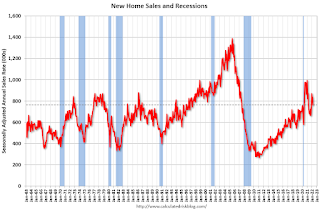 Click on graph for larger image.
Click on graph for larger image.The first graph shows New Home Sales vs. recessions since 1963. The dashed line is the current sales rate.
New home sales are now declining year-over-year since sales soared following the first few months of the pandemic.
The second graph shows New Home Months of Supply.
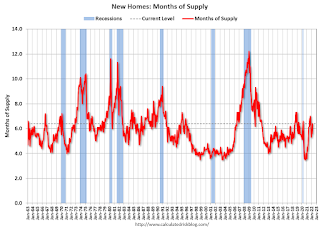 The months of supply increased in March to 6.4 months from 5.6 months in February.
The months of supply increased in March to 6.4 months from 5.6 months in February. The all-time record high was 12.1 months of supply in January 2009. The all-time record low was 3.5 months, most recently in October 2020.
This is above the top of the normal range (about 4 to 6 months of supply is normal).
"The seasonally‐adjusted estimate of new houses for sale at the end of March was 407,000. This represents a supply of 6.4 months at the current sales rate"
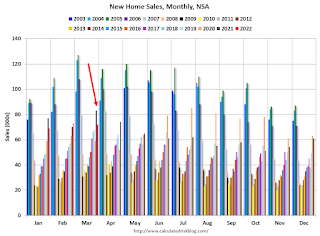 The last graph shows sales NSA (monthly sales, not seasonally adjusted annual rate).
The last graph shows sales NSA (monthly sales, not seasonally adjusted annual rate).In March 2022 (red column), 72 thousand new homes were sold (NSA). Last year, 83 thousand homes were sold in March.
The all-time high for March was 127 thousand in 2005, and the all-time low for March was 28 thousand in 2011.
This was below expectations, however sales in the three previous months were revised up sharply. I'll have more later today.
Case-Shiller: National House Price Index increased 19.8% year-over-year in February
by Calculated Risk on 4/26/2022 09:16:00 AM
S&P/Case-Shiller released the monthly Home Price Indices for February ("February" is a 3-month average of December, January and February prices).
This release includes prices for 20 individual cities, two composite indices (for 10 cities and 20 cities) and the monthly National index.
From S&P: S&P Corelogic Case-Shiller Index Shows Annual Home Price Gains Increased To 19.8% In February
The S&P CoreLogic Case-Shiller U.S. National Home Price NSA Index, covering all nine U.S. census divisions, reported a 19.8% annual gain in February, up from 19.1% in the previous month. The 10-City Composite annual increase came in at 18.6%, up from 17.3% in the previous month. The 20-City Composite posted a 20.2% year-over-year gain, up from 18.9% in the previous month.
Phoenix, Tampa, and Miami reported the highest year-over-year gains among the 20 cities in February. Phoenix led the way with a 32.9% year-over-year price increase, followed by Tampa with a 32.6% increase and Miami with a 29.7% increase. All 20 cities reported higher price increases in the year ending February 2022 versus the year ending January 2022.
...
Before seasonal adjustment, the U.S. National Index posted a 1.7% month-over-month increase in February, while the 10-City and 20-City Composites both posted increases of 2.4%.
After seasonal adjustment, the U.S. National Index posted a month-over-month increase of 1.9%, and the 10-City and 20-City Composites both posted increases of 2.3% and 2.4%, respectively.
In February, all 20 cities reported increases before and after seasonal adjustments.
“U.S. home prices continued to advance at a very rapid pace in February,” says Craig J. Lazzara, Managing Director at S&P DJI. “The National Composite Index recorded a gain of 19.8% for the 12 months ended February 2022; the 10- and 20-City Composites rose 18.6% and 20.2%, respectively.All three composites reflect an acceleration of price growth relative to January’s level.
...
“The macroeconomic environment is evolving rapidly and may not support extraordinary home price growth for much longer. The post-COVID resumption of general economic activity has stoked inflation, and the Federal Reserve has begun to increase interest rates in response. We may soon begin to see the impact of increasing mortgage rates on home prices.”
emphasis added
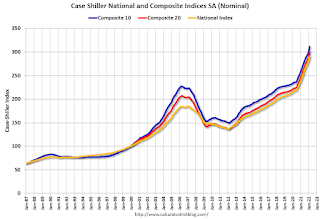 Click on graph for larger image.
Click on graph for larger image. The first graph shows the nominal seasonally adjusted Composite 10, Composite 20 and National indices (the Composite 20 was started in January 2000).
The Composite 10 index is up 2.3% in February (SA).
The Composite 20 index is up 2.4% (SA) in February.
The National index is 57% above the bubble peak (SA), and up 1.9% (SA) in February. The National index is up 112% from the post-bubble low set in February 2012 (SA).
 The second graph shows the year-over-year change in all three indices.
The second graph shows the year-over-year change in all three indices.The Composite 10 SA is up 18.6% year-over-year. The Composite 20 SA is up 20.2% year-over-year.
The National index SA is up 19.8% year-over-year.
Price increases were above expectations. I'll have more later.
Monday, April 25, 2022
Tuesday: New Home Sales, Case-Shiller House Prices, Durable Goods, Richmond Fed Mfg
by Calculated Risk on 4/25/2022 09:15:00 PM
From Matthew Graham at Mortgage News Daily: Mortgage Rates Regain Most of What They Lost Late Last Week
Thursday and Friday weren't great days for the mortgage market last week. ... One business day later, and lenders are closer to territory from the first 3 days of last week. This is roughly an eighth of a percentage point lower than Friday's rates fore most lenders (i.e. 5.375% instead of 5.5%). As always, these rates may not apply to every scenario and the best way to use this data is for the purpose of tracking day-over-day changes. [30 year fixed 5.32%]Tuesday:
emphasis added
• At 8:30 AM ET, Durable Goods Orders for March from the Census Bureau. The consensus is for a 1.0% increase in durable goods orders.
• At 9:00 AM, S&P/Case-Shiller House Price Index for February. The consensus is for a 18.4% year-over-year increase in the Comp 20 index for February.
• Also at 9:00 AM, FHFA House Price Index for February. This was originally a GSE only repeat sales, however there is also an expanded index.
• At 10:00 AM, New Home Sales for March from the Census Bureau. The consensus is for 762 thousand SAAR, down from 772 thousand in February.
• Also at 10:00 AM, Richmond Fed Survey of Manufacturing Activity for April.
On COVID (focus on hospitalizations and deaths):
| COVID Metrics | ||||
|---|---|---|---|---|
| Now | Week Ago | Goal | ||
| Percent fully Vaccinated | 66.1% | --- | ≥70.0%1 | |
| Fully Vaccinated (millions) | 219.4 | --- | ≥2321 | |
| New Cases per Day3🚩 | 44,416 | 36,209 | ≤5,0002 | |
| Hospitalized3 | 9,518 | 9,754 | ≤3,0002 | |
| Deaths per Day3 | 314 | 362 | ≤502 | |
| 1 Minimum to achieve "herd immunity" (estimated between 70% and 85%). 2my goals to stop daily posts, 37-day average for Cases, Currently Hospitalized, and Deaths 🚩 Increasing 7-day average week-over-week for Cases, Hospitalized, and Deaths ✅ Goal met. | ||||
 Click on graph for larger image.
Click on graph for larger image.This graph shows the daily (columns) and 7-day average (line) of deaths reported.
Average daily deaths bottomed in July 2021 at 214 per day.
Freddie Mac: Mortgage Serious Delinquency Rate decreased in March
by Calculated Risk on 4/25/2022 04:35:00 PM
Freddie Mac reported that the Single-Family serious delinquency rate in March was 0.92%, down from 0.99% February. Freddie's rate is down year-over-year from 2.34% in March 2021.
Freddie's serious delinquency rate peaked in February 2010 at 4.20% following the housing bubble and peaked at 3.17% in August 2020 during the pandemic.
These are mortgage loans that are "three monthly payments or more past due or in foreclosure".
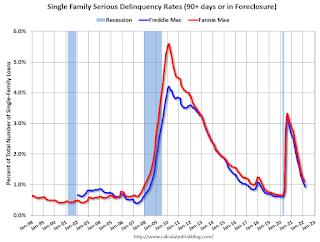
Mortgages in forbearance are being counted as delinquent in this monthly report but are not reported to the credit bureaus.
This is very different from the increase in delinquencies following the housing bubble. Lending standards have been fairly solid over the last decade, and most of these homeowners have equity in their homes - and they will be able to restructure their loans once (if) they are employed.
Housing and Demographics
by Calculated Risk on 4/25/2022 11:07:00 AM
Today, in the Calculated Risk Real Estate Newsletter: Housing and Demographics
A brief excerpt:
The current demographics are now very favorable for home buying - and will remain somewhat positive for most of the decade, although most of the increase is now behind us.There is much more in the article.
Here is an even longer-term graph from 1960 through 2060. The surge in baby boomers reaching their 20s (red), led to a huge increase in apartment construction in the early 1970s.
Then home-buying became favorable in the late ‘70s, but housing still slumped in the ‘79 to ‘82 period as the Volcker Fed raised interest rates to fight inflation. This is one reason I’ve been arguing Don't Compare the Current Housing Boom to the Bubble and Bust, look instead to the 1978 to 1982 period for lessons.
...
Population data is very useful in predicting long term trends, however, other factors (like in the 1980 period) can overwhelm demographics in the short term.
Housing Inventory April 25th Update: Inventory up 1.7% Week-over-week; Up 14.2% from Seasonal Bottom
by Calculated Risk on 4/25/2022 09:02:00 AM
Tracking existing home inventory is very important in 2022.
Inventory usually declines in the winter, and then increases in the spring. Inventory bottomed seasonally at the beginning of March 2022 and is now up 14.2% since then.

This inventory graph is courtesy of Altos Research.
Last year inventory bottomed seasonally in April 2021 - very late in the year. This year, by this measure, inventory bottomed seasonally at the beginning of March.
Inventory is still very low. Compared to the same week in 2021, inventory is down 11.2% from 310 thousand, and compared to the same week in 2020, and inventory is down 63.1% from 746 thousand.
One of the keys will be to watch the year-over-year change each week to see if the declines are decreasing. Here is a table of the year-over-year change by week since the beginning of the year.
| Week Ending | YoY Change |
|---|---|
| 12/31/2021 | -30.0% |
| 1/7/2022 | -26.0% |
| 1/14/2022 | -28.6% |
| 1/21/2022 | -27.1% |
| 1/28/2022 | -25.9% |
| 2/4/2022 | -27.9% |
| 2/11/2022 | -27.5% |
| 2/18/2022 | -25.8% |
| 2/25/2022 | -24.9% |
| 3/4/2022 | -24.2% |
| 3/11/2022 | -21.7% |
| 3/18/2022 | -21.7% |
| 3/25/2022 | -19.0% |
| 4/1/2022 | -17.6% |
| 4/8/2022 | -14.8% |
| 4/15/2022 | -13.1% |
| 4/22/2022 | -11.2% |
Four High Frequency Indicators for the Economy
by Calculated Risk on 4/25/2022 08:31:00 AM
These indicators are mostly for travel and entertainment. It is interesting to watch these sectors recover as the pandemic subsides. Note: Apple has discontinued "Apple mobility", and restaurant traffic is mostly back to normal.
The TSA is providing daily travel numbers.
This data is as of April 24th.
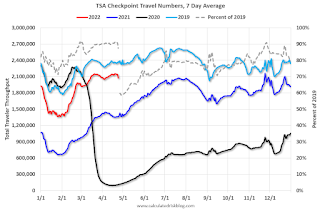 Click on graph for larger image.
Click on graph for larger image.This data shows the 7-day average of daily total traveler throughput from the TSA for 2019 (Light Blue), 2020 (Black), 2021 (Blue) and 2022 (Red).
The dashed line is the percent of 2019 for the seven-day average.
The 7-day average is down 12.6% from the same day in 2019 (87.4% of 2019). (Dashed line)
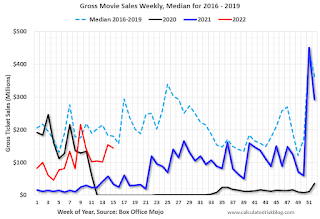 This data shows domestic box office for each week and the median for the years 2016 through 2019 (dashed light blue).
This data shows domestic box office for each week and the median for the years 2016 through 2019 (dashed light blue). Note that the data is usually noisy week-to-week and depends on when blockbusters are released.
Movie ticket sales were at $145 million last week, down about 20% from the median for the week.
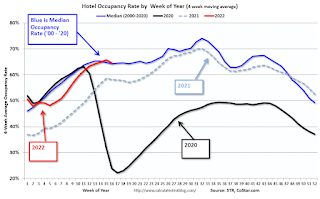 This graph shows the seasonal pattern for the hotel occupancy rate using the four-week average.
This graph shows the seasonal pattern for the hotel occupancy rate using the four-week average. The red line is for 2022, black is 2020, blue is the median, and dashed light blue is for 2021.
This data is through April 16th. The occupancy rate was down 5.6% compared to the same week in 2019.
Notes: Y-axis doesn't start at zero to better show the seasonal change.
Here is some interesting data on New York subway usage (HT BR).
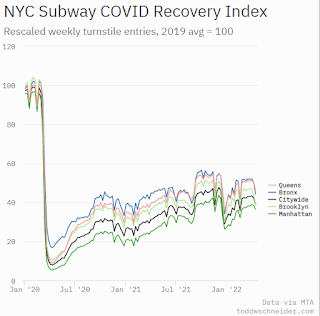 This graph is from Todd W Schneider.
This graph is from Todd W Schneider. This data is through Friday, April 22nd.
He notes: "Data updates weekly from the MTA’s public turnstile data, usually on Saturday mornings".
Black Knight: "Mortgage Delinquencies Hit Record Low in March"
by Calculated Risk on 4/25/2022 08:05:00 AM
Note: At the beginning of the pandemic, the delinquency rate increased sharply. Loans in forbearance are counted as delinquent in this survey, but those loans are not reported as delinquent to the credit bureaus. Foreclosures are starting to increase following the end of the moratorium, but are at very low levels (see: Delinquencies, Foreclosures and REO) for a discussion of rising foreclosures, and why this isn't a concern)
From Black Knight: Black Knight: Mortgage Delinquencies Hit Record Low in March, Driven by Both Seasonal and Broader Economic Improvements; Prepays Up Despite Rate Increases
• The national delinquency rate dropped by more than half a percentage point in March, falling to 2.84% and shattering the previous record low of 3.22% in January 2020According to Black Knight's First Look report, the percent of loans delinquent decreased 15.5% in March compared to February and decreased 43% year-over-year.
• While March typically sees the strongest mortgage performance of any month – with delinquencies falling more than 10% on average over the past 20 years – this year’s 15.5% reduction was exceptionally strong
• Robust employment, continued student loan deferrals, strong post-forbearance performance and millions of refinances into record-low interest rates have all helped put downward pressure on delinquency rates
• The strongest improvement was seen among borrowers who are a single payment past due, with 30-day delinquencies recording a 20% month-over-month decline
• Though serious delinquencies – those 90 or more days past due but not in foreclosure – fell 12% for the strongest single-month improvement in 20 years, they remain 70% above pre-pandemic levels
• Despite elevated serious delinquencies, foreclosure starts fell by 3% from the month prior and are holding well below pre-pandemic levels
• The number of active foreclosures edged slightly higher in March, marking the first year-over-year increase in almost 10 years, though inventories also remain well below pre-pandemic levels
• Prepayment activity bucked the recent trend of sharply rising interest rates driving falling prepay speeds, rising by 9% in March, likely driven at least in part by seasonal increases in home sales-related prepays
emphasis added
The percent of loans in the foreclosure process increased 3.7% in March and were up 3.9% over the last year. (First year-over-year increase in almost 10 years - but from very low levels)
Black Knight reported the U.S. mortgage delinquency rate (loans 30 or more days past due, but not in foreclosure) was 2.84% in March, down from 3.36% in February.
The percent of loans in the foreclosure process increased in March to 0.32%, from 0.31% in February.
The number of delinquent properties, but not in foreclosure, is down 1,159,000 properties year-over-year, and the number of properties in the foreclosure process is up 7,000 properties year-over-year.
| Black Knight: Percent Loans Delinquent and in Foreclosure Process | ||||
|---|---|---|---|---|
| Mar 2022 | Feb 2022 | Mar 2021 | Mar 2020 | |
| Delinquent | 2.84% | 3.36% | 5.02% | 3.39% |
| In Foreclosure | 0.32% | 0.31% | 0.30% | 0.42% |
| Number of properties: | ||||
| Number of properties that are delinquent, but not in foreclosure: | 1,513,000 | 1,783,000 | 2,672,000 | 1,792,000 |
| Number of properties in foreclosure pre-sale inventory: | 169,000 | 162,000 | 162,000 | 220,000 |
| Total Properties | 1682,000 | 1,946,000 | 2,834,000 | 2,013,000 |



